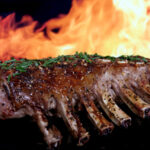Using a smoker makes chicken, pork spare ribs, beef briskets, seafood and lamb taste incredibly delicious. Even a novice barbecue chef can achieve that famous smokehouse flavor right in their own backyard. Get a ready-to-fire-up or ready-to-assemble metal flip-top or vertical stacker model and you will be up and smokin’ in no time. Add a rub with your favorite herbs and spices to flavor meats. While you are tantalizing your neighbors with the aroma and protectively tending your meat, follow the number one rule for smokers at all times: keep it slow and keep it low.
Step 1- Get the Right Wood, Baby!
Select the type of wood you want to use with your wood-burning smoker, such as mesquite, hickory, apple, pecan, maple or alder. Use wood logs or chunks especially made for smoking. Avoid relying on wood chips alone in your smoker, as they will burn down too quickly for the smoking process. Soak one-half of the chunks or one-half of the logs in water for at least thirty minutes.
Step 2 – Light Your Fire
Start a fire with the wood logs inside your smoker. Avoid using any kerosene-based fluid because it will take a while to burn off, and the fluid smell will get into the meat. Keep a large water can accessible at all times to put out high flames. Let the wood die-down to the point where it is not on flame. Put the soaked logs and chunks on top of the wood that is smoking to create steam that will penetrate the meat.
Step 3 – Keepin’ It Moist and Meaty
Consider the option of adding an aluminum or steel pan on the lowest rack inside your smoker, or place it on top of the wood chunks, to incorporate steam as an additional cooking “fuel.” Fill the pan two-thirds of the way with water. Add herbs such as rosemary, tarragon, thyme and garlic to “flavor” the smoke and permeate the meat. Use a 1:10 ratio of beer or wine with water for additional flavoring, along with slices of lemon, oranges and/or lime.
Step 4 – Rub, Dry and Wet Marinades
Marinade the meats with a dry or wet rub. Use your own “house favorite” custom rub, a ready-made rub from the grocer or try a wet Jamaican “jerk” rub for a tropical and spicy flavor. Marinade the meat while the fire is getting ready, or several hours in advance.
Step 5 – Low and Slow
Check the temperature inside of the smoker and wait until it registers in range of 200 to 275 F before adding the meats.
Step 6 – “Top Shelf” Treatment
Place the meats on the top rack of the smoker, above the water pan (if used), and as far away from the heat of the wood as possible so the meat cooks indirectly.
Step 7 – Turn Baby, Turn
Rotate the meat about halfway through the cooking process. Allow an hour or an hour and a half of cooking time for each pound of a large meat, and 20 minutes for small pieces like chicken. Limit the amount of times you open the door of the smoker, because each time you open the door the heat escapes, extending the cooking time. Use a meat thermometer for extra assurance that meats are thoroughly cooked.
Step 8 – Add a Great Baste
Baste the meat with sauce during the last half hour or one hour of cooking, if you want meat that has a caramelized layer of sauce on top. Remove the meats from the smoker and let them “rest” for 20 minutes before adding sauce – or add the sauce during the last 20 minutes of smoking to get that charred sauce look on the top of the meats.
Smoker Buying Tips
If you are buying a smoker, look for one with vents on the top and the bottom for the best ventilation. Check with firewood sellers for the best selection of wood logs and chunks.
Beware
Use gloves when working with a smoker, you can still burn your fingers when you place your hand inside, even though smokers are not as hot as regular barbecue grills.




